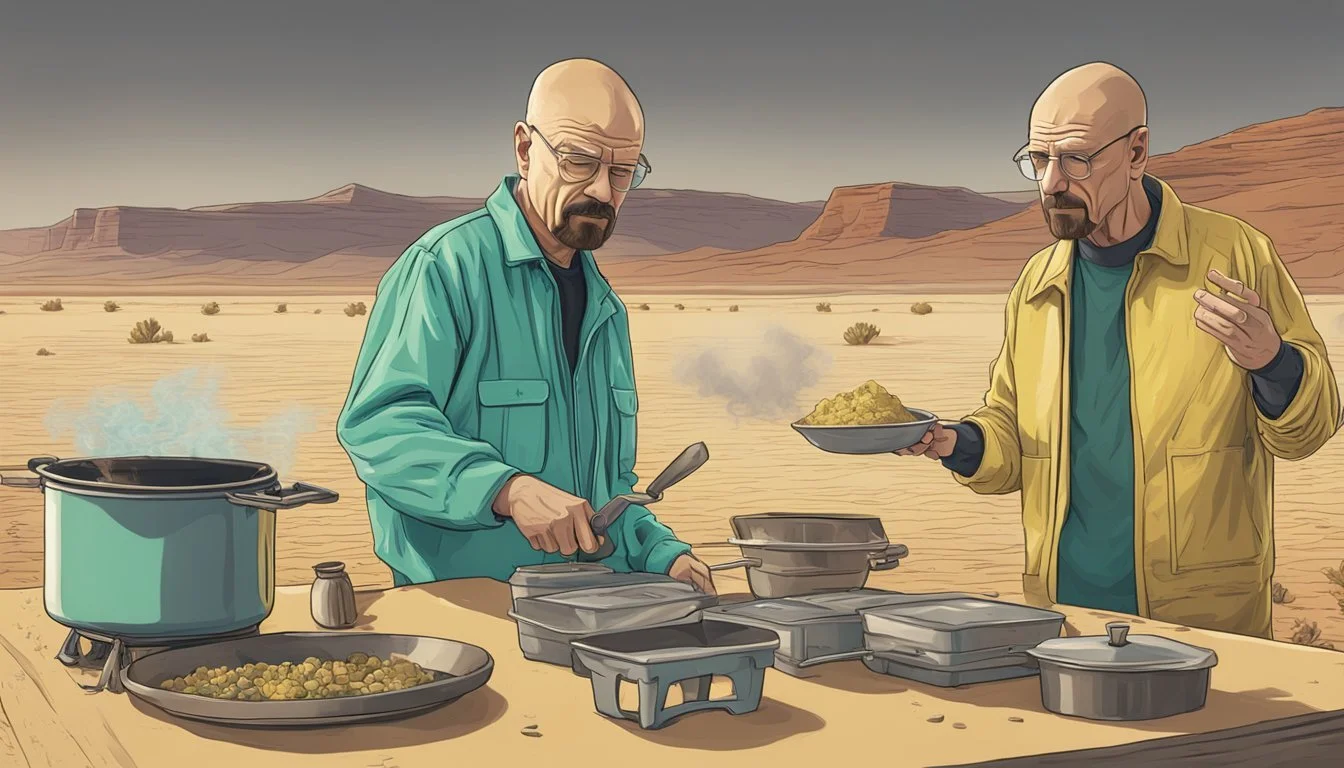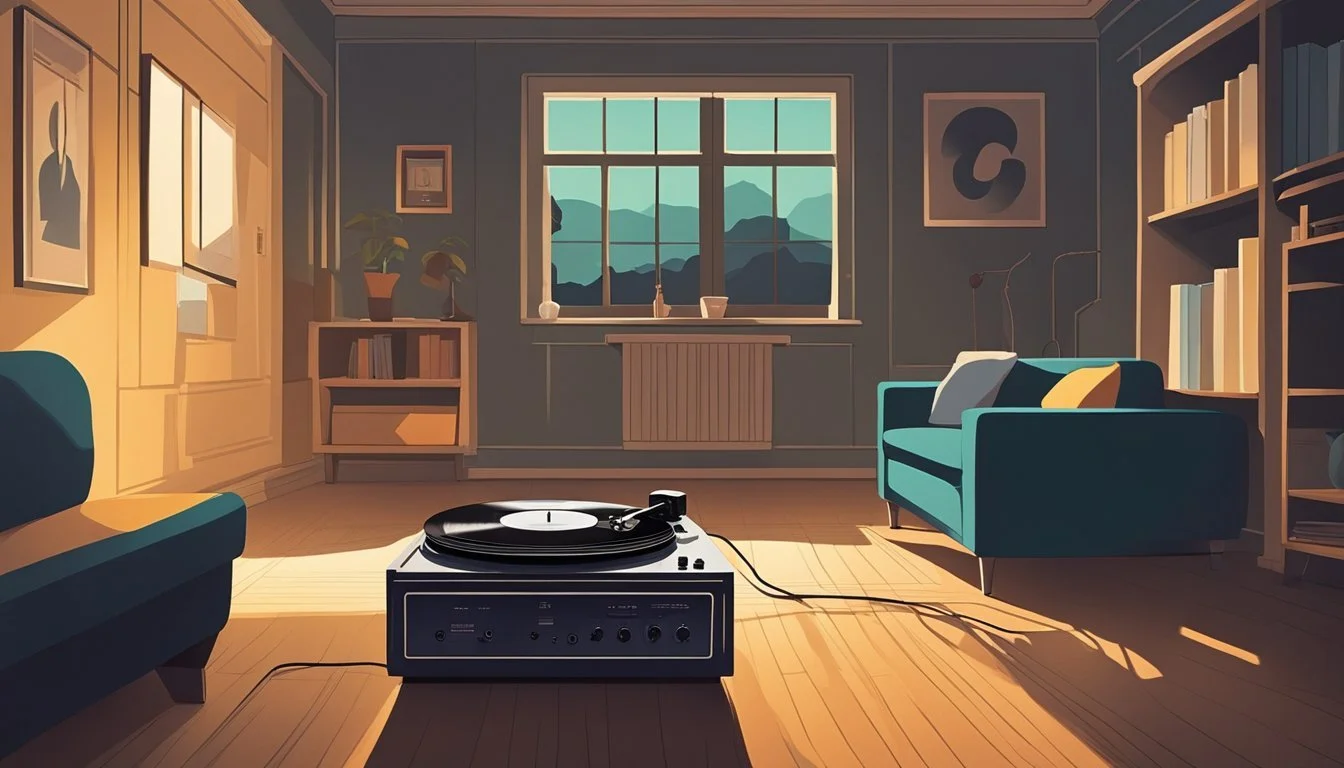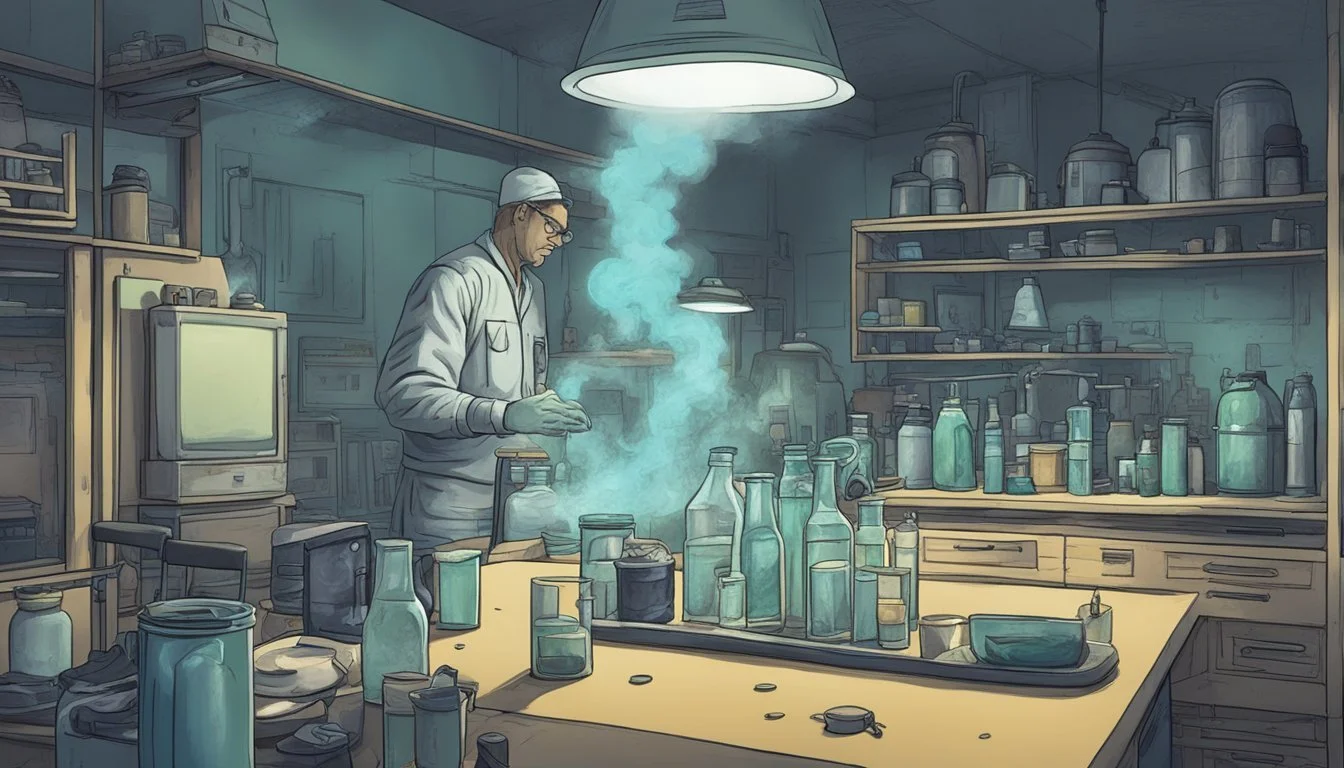The Role of Music in Breaking Bad: From Diegetic to Non-Diegetic
A Sonic Journey Through Walter White's World
Breaking Bad's music played a vital role in shaping the show's atmosphere and character development. From the haunting original score by Dave Porter to carefully chosen songs, the soundtrack enhanced Walter White's transformation and heightened emotional impact throughout the series.
The interplay between diegetic and non-diegetic music in Breaking Bad created a rich auditory landscape that deepened the viewing experience. Diegetic music, originating from sources within the story world, grounded scenes in reality. Non-diegetic music, added in post-production, provided emotional cues and thematic resonance.
This blending of musical elements mirrored the show's blurring of moral lines. As Walter descended into the criminal underworld, the soundtrack shifted to reflect his changing identity. The strategic use of both diegetic and non-diegetic music amplified tension, foreshadowed events, and underscored character motivations throughout Breaking Bad's five-season run.
Conceptual Foundations of Music in Film
Music plays a crucial role in shaping the cinematic experience. It can originate from within the story world or exist outside of it, serving various narrative and emotional functions.
Defining Diegetic and Non-Diegetic Music
Diegetic music comes from sources visible on screen or implied to exist within the film's world. Characters can hear and interact with it. Examples include a radio playing in a scene or a character singing.
Non-diegetic music, in contrast, is added for the audience's benefit. It exists outside the story world and is not audible to the characters. This typically includes background scores and mood-setting pieces.
These terms, introduced by Claudia Gorbman over four decades ago, have become fundamental in film music studies. They help categorize and analyze how music functions within a film's narrative structure.
Diegetic Music and Its Functions
Diegetic music serves multiple purposes in film:
Establishing setting and time period
Revealing character traits and preferences
Advancing the plot
Creating realistic ambiance
It can also bridge scenes or highlight important moments. For example, a song playing on a car radio might foreshadow upcoming events or reflect a character's emotional state.
Diegetic music often has a natural, raw quality. Its presence in the story world allows for creative transitions between diegetic and non-diegetic sounds.
Non-Diegetic Music and Its Roles
Non-diegetic music, often referred to as the film score, fulfills several key functions:
Establishing mood and atmosphere
Enhancing emotional impact of scenes
Guiding audience reactions
Providing continuity between scenes
Reinforcing thematic elements
It can subtly influence viewers' perceptions and interpretations of on-screen events. Non-diegetic music has the power to elevate tension, create suspense, or evoke specific emotions without being directly tied to the visible action.
Interplay Between Diegetic and Non-Diegetic Sounds
The boundary between diegetic and non-diegetic music is not always clear-cut. Filmmakers often play with this distinction to create unique effects.
A diegetic song might seamlessly transition into a non-diegetic orchestral arrangement. This technique can blur the line between the characters' reality and the audience's experience.
Sound design plays a crucial role in this interplay. It can manipulate volume, clarity, and spatial characteristics of music to shift between diegetic and non-diegetic realms.
Some films intentionally create ambiguity about the source of music. This can lead to moments of surprise or revelation when the source is finally revealed.
Breaking Bad's Narrative and Musical Landscape
Breaking Bad's narrative structure and character development are intricately woven with its musical landscape. The show's music serves as a powerful narrative device, enhancing storytelling and reinforcing character themes through carefully chosen motifs.
Narrative Structure and Character Development
Breaking Bad's narrative unfolds as a tragic descent, chronicling Walter White's transformation from a mild-mannered chemistry teacher to a ruthless drug kingpin. This character arc is mirrored in the show's evolving musical palette. Early episodes feature lighter, more ambient sounds that gradually give way to darker, more intense compositions as the plot progresses.
The show's episodic structure often builds tension through cliffhangers and non-linear storytelling. Music plays a crucial role in maintaining this tension across episodes and seasons. Recurring musical themes help tie disparate plot threads together, creating a cohesive narrative experience.
Music as a Narrative Device
Breaking Bad's creators use music to enhance key plot points and emotional moments. Diegetic music - songs played within the show's world - often comments on or foreshadows events. For example, the song "Crystal Blue Persuasion" plays during a montage of Walter's expanding meth operation, its lyrics mirroring the plot.
Non-diegetic music, including Dave Porter's original score, guides viewers' emotional responses to scenes. Tense, discordant sounds heighten suspense during dangerous encounters, while softer melodies underscore rare moments of peace or reflection.
Character Themes and Motifs
Each major character in Breaking Bad has associated musical motifs that evolve with their arcs. Walter White's theme begins as a simple, hesitant melody that grows more complex and menacing as he embraces his Heisenberg persona. Jesse Pinkman's music often incorporates elements of hip-hop, reflecting his background and youthful energy.
These leitmotifs serve as auditory shorthand, instantly conveying a character's presence or influence in a scene. As characters' relationships change, their themes interact and blend in new ways, musically representing the shifting dynamics of the plot.
Technical Aspects of Music in Breaking Bad
Breaking Bad's music incorporated sophisticated sound design, meticulous selection processes, and an original score to create its distinctive auditory atmosphere. These technical elements worked in harmony to enhance the storytelling and emotional impact of the series.
Sound Design and Post-Production Integration
The sound design in Breaking Bad played a crucial role in crafting the show's immersive environment. Ambient sounds were carefully layered to create tension and realism. Diegetic sounds, like the buzz of fluorescent lights, were amplified for dramatic effect.
Post-production techniques enhanced the musical elements. Mixing and mastering processes ensured seamless integration of score, licensed tracks, and sound effects. Dynamic range compression was used judiciously to maintain clarity in dialogue-heavy scenes while allowing musical crescendos during intense moments.
Sound designers employed creative techniques like pitch-shifting and time-stretching to manipulate audio elements, creating unique sonic textures that complemented the visual storytelling.
Music Selection and Synchronization
Music supervisors for Breaking Bad curated a diverse soundtrack that enhanced pivotal scenes. Licensed tracks were chosen for their lyrical relevance and emotional resonance with the narrative.
Precise synchronization of music to on-screen action was achieved through advanced editing software. This allowed for seamless transitions between scenes and heightened dramatic moments.
The team utilized temp tracks during the editing process to test musical ideas before finalizing selections. This approach ensured that chosen pieces effectively supported the storytelling without overpowering the visuals or dialogue.
Original Score and its Composition
Dave Porter's original score for Breaking Bad utilized a blend of electronic and organic instruments to create a unique sonic palette. Synthesizers and processed guitar tones were combined with traditional orchestral elements.
Porter employed leitmotifs - recurring musical themes associated with specific characters or concepts. These motifs evolved throughout the series, mirroring character development.
The composition process involved close collaboration with showrunner Vince Gilligan to align musical themes with narrative arcs. Porter used digital audio workstations and sample libraries to craft demo versions of cues, which were then refined based on feedback.
Scoring sessions often involved recording live musicians to add depth and nuance to the electronic elements, creating a rich, textured soundscape that became integral to the show's identity.
Cultural and Artistic Influence
Breaking Bad's soundtrack weaves together diverse musical genres and cultural references. This fusion creates a rich tapestry that enhances the show's narrative and emotional depth.
Influence of Opera and Classical Music
Opera and classical music play significant roles in Breaking Bad's soundscape. The show incorporates pieces from renowned composers to underscore dramatic moments. Wagner's "Ride of the Valkyries" accompanies a pivotal scene, amplifying its intensity.
Andrew Lloyd Webber's "The Phantom of the Opera" features in a memorable montage. This unexpected choice adds layers of meaning to the visuals. Classical music often serves as a counterpoint to the gritty realism of the show's setting.
Jazz and Contemporary Music in Breaking Bad
Jazz and contemporary tracks provide contrast to the classical selections. These genres reflect the show's modern setting and characters' complexities. Miles Davis's cool jazz creates a sophisticated atmosphere in key scenes.
Contemporary artists like TV on the Radio contribute to the soundtrack. Their music adds a current edge to the series. The mix of jazz and modern tracks keeps the audio landscape dynamic and unpredictable.
Cultural References and Their Significance
Breaking Bad's music choices often contain subtle cultural nods. These references deepen the viewing experience for attentive audiences. The use of narcocorridos, Mexican drug ballads, adds authenticity to cartel-related scenes.
The show's musical selections sometimes foreshadow plot developments. Lyrics and themes in chosen songs hint at characters' fates. This clever use of music transforms the soundtrack into a storytelling tool.
Art and culture intersect in Breaking Bad's musical landscape. Album artwork and music videos occasionally appear on screen. These visual elements complement the audio, creating a multi-layered artistic experience.
Psychological Impact of Music on Viewers
Music in Breaking Bad wields significant psychological power over viewers. It shapes perceptions, elicits emotions, and enhances the narrative in profound ways.
Creating Mood and Atmosphere
The carefully selected music in Breaking Bad establishes distinct moods and atmospheres for different scenes. Upbeat tracks like "Crystal Blue Persuasion" contrast sharply with somber pieces, mirroring the show's tonal shifts.
Dave Porter's original score uses eerie synths and percussive elements to build tension and unease. This musical backdrop primes viewers emotionally for upcoming events.
In key moments, silence itself becomes a powerful tool. The absence of music heightens suspense and draws viewers deeper into the characters' psychological states.
Music and Emotional Manipulation
Breaking Bad's soundtrack serves as an emotional guide for viewers. Familiar songs take on new meanings when paired with intense scenes, creating cognitive dissonance.
For example, the use of cheerful oldies during violent montages unsettles viewers and highlights the characters' moral decay. This juxtaposition of sound and image manipulates audience reactions.
Research shows that music can significantly influence viewers' interpretations of film narratives. Breaking Bad leverages this effect to shape perceptions of characters and events.
Breaking the Fourth Wall with Sound
Breaking Bad occasionally uses music to bridge the gap between the show's world and reality. Diegetic music - songs that characters can hear - blurs the line between fiction and reality.
When Walter White sings along to "Horse with No Name" in his car, viewers share in his momentary escape. This creates a sense of intimacy and authenticity.
Non-diegetic music transitions to diegetic in some scenes, drawing attention to the constructed nature of the show. This technique challenges viewers' immersion and prompts reflection on the narrative.
Comparative Analysis with Other Cinematic Works
Breaking Bad's innovative use of music sets it apart from many television shows and films. Its approach to diegetic and non-diegetic sound creates a unique auditory experience that enhances the storytelling.
Breaking Bad vs. Other Television Shows
Breaking Bad's musical approach differs from many TV dramas. While shows like The Sopranos use licensed tracks to set mood, Breaking Bad relies heavily on original compositions. This creates a distinct sonic identity.
The series also employs silence effectively, contrasting with dialogue-heavy shows. Moments of quiet tension build suspense in ways rarely seen on television.
Breaking Bad's use of diegetic music is particularly notable. Songs played within scenes often carry deeper meaning, like the narcocorridos in Heisenberg's early days. This technique is more common in cinema than television.
Film Music: Breaking Bad and Cinema
Breaking Bad's score shares similarities with minimalist film composers like Philip Glass. Both use repetitive patterns to create tension and unease. This approach echoes Glass's work on The Truman Show, where music builds an artificial world.
The series also draws from Western film scores, using sparse instrumentation to evoke a modern frontier. This recalls Ennio Morricone's work on spaghetti Westerns.
Breaking Bad's music differs from blockbuster franchises like Star Wars. While Star Wars uses leitmotifs for characters, Breaking Bad's themes are more situational, evolving with the plot.
The show's blend of diegetic and non-diegetic music blurs reality, a technique used in films like Birdman. This creates a seamless audio landscape that enhances the viewing experience.
Music's Role in Audience Engagement and Consumption
Music plays a crucial role in shaping audience engagement and consumption patterns. It serves as a powerful tool for marketers and influences how listeners interact with content across various platforms.
Sound and Music as Tools for Marketing
Background music in retail spaces can significantly impact consumer behavior. Slow-tempo music encourages shoppers to spend more time browsing, while upbeat tunes create a lively atmosphere. In advertising, jingles and theme songs boost brand recognition and recall.
On social media, music-driven content like TikTok videos often goes viral, exposing brands to wider audiences. Streaming platforms use algorithms to suggest new artists based on listening history, keeping users engaged for longer periods.
Audience Consumption Patterns Around Music
Streaming services have revolutionized music consumption. Listeners now create personalized playlists for different moods and activities. Background music apps offer curated soundscapes for work or relaxation.
Live music experiences remain popular, with fans seeking immersive concerts and festivals. Virtual reality concerts emerged as a new format, allowing global audience participation from home.
Music discovery has shifted largely online. Social media influencers and user-generated content drive trends and introduce new artists to listeners. Podcast integration of music clips exposes audiences to diverse genres and artists.
Innovations and Future Directions in Sound and Music
Technological advancements are revolutionizing sound design and music experiences. New tools and formats are expanding creative possibilities and audience engagement.
Emerging Technologies in Sound Design
AI-powered audio tools are transforming music production. Machine learning algorithms can generate original melodies, harmonies, and rhythms. Producers use these to spark creativity or fill gaps in compositions.
Spatial audio technologies create immersive 3D soundscapes. Listeners perceive sounds coming from different directions and distances. This enhances realism in gaming, virtual reality, and music playback.
Blockchain enables new music distribution and royalty models. Artists can release limited edition digital assets tied to songs. Smart contracts automate payments to collaborators.
Music in Virtual Reality and Immersive Formats
VR concerts transport fans into digital venues with their favorite artists. Attendees can interact with 3D visualizations synced to the music. Some platforms allow socializing with other virtual concertgoers.
360-degree music videos place viewers at the center of the action. Users can look around and explore as the song plays. This creates a more engaging and memorable experience.
Augmented reality adds visual and audio layers to live performances. Concertgoers see holographic effects or additional instruments through AR glasses. This blends physical and digital elements seamlessly.
Conclusion
Music played a pivotal role in Breaking Bad's storytelling. The show expertly blended diegetic and non-diegetic sounds to enhance its narrative and emotional impact.
Diegetic music, heard by characters within scenes, grounded the story in reality. It provided cultural context and character insights through their musical choices.
Non-diegetic music, including Dave Porter's original score, heightened tension and underscored Walter White's transformation. These atmospheric compositions became synonymous with the show's dark themes.
Breaking Bad's innovative use of music influenced subsequent TV dramas. It demonstrated how carefully chosen songs and original scores can elevate a series beyond mere entertainment.
The show's musical approach highlights the evolving landscape of film and TV music. Creators now recognize music as an essential storytelling tool, not just background noise.
As production values in television continue to rise, we can expect even more sophisticated and impactful uses of music in future series. Breaking Bad set a high bar for integrating music into visual storytelling.







